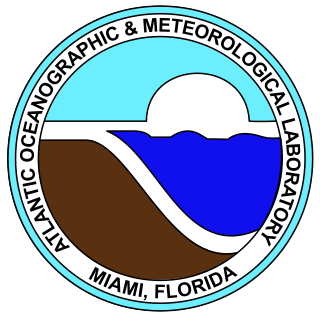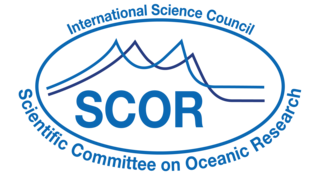Related Research Articles

The carbon cycle is that part of the biogeochemical cycle by which carbon is exchanged among the biosphere, pedosphere, geosphere, hydrosphere, and atmosphere of Earth. Other major biogeochemical cycles include the nitrogen cycle and the water cycle. Carbon is the main component of biological compounds as well as a major component of many minerals such as limestone. The carbon cycle comprises a sequence of events that are key to making Earth capable of sustaining life. It describes the movement of carbon as it is recycled and reused throughout the biosphere, as well as long-term processes of carbon sequestration (storage) to and release from carbon sinks.

Atmospheric science is the study of the Earth's atmosphere and its various inner-working physical processes. Meteorology includes atmospheric chemistry and atmospheric physics with a major focus on weather forecasting. Climatology is the study of atmospheric changes that define average climates and their change over time, due to both natural and anthropogenic climate variability. Aeronomy is the study of the upper layers of the atmosphere, where dissociation and ionization are important. Atmospheric science has been extended to the field of planetary science and the study of the atmospheres of the planets and natural satellites of the Solar System.

The biological pump (or ocean carbon biological pump or marine biological carbon pump) is the ocean's biologically driven sequestration of carbon from the atmosphere and land runoff to the ocean interior and seafloor sediments. In other words, it is a biologically mediated process which results in the sequestering of carbon in the deep ocean away from the atmosphere and the land. The biological pump is the biological component of the "marine carbon pump" which contains both a physical and biological component. It is the part of the broader oceanic carbon cycle responsible for the cycling of organic matter formed mainly by phytoplankton during photosynthesis (soft-tissue pump), as well as the cycling of calcium carbonate (CaCO3) formed into shells by certain organisms such as plankton and mollusks (carbonate pump).
The Carl-Gustaf Rossby Research Medal is the highest award for atmospheric science of the American Meteorological Society. It is presented to individual scientists, who receive a medal. Named in honor of meteorology and oceanography pioneer Carl-Gustaf Rossby, who was also its second (1953) recipient.

A biogeochemical cycle, or more generally a cycle of matter, is the movement and transformation of chemical elements and compounds between living organisms, the atmosphere, and the Earth's crust. Major biogeochemical cycles include the carbon cycle, the nitrogen cycle and the water cycle. In each cycle, the chemical element or molecule is transformed and cycled by living organisms and through various geological forms and reservoirs, including the atmosphere, the soil and the oceans. It can be thought of as the pathway by which a chemical substance cycles the biotic compartment and the abiotic compartments of Earth. The biotic compartment is the biosphere and the abiotic compartments are the atmosphere, lithosphere and hydrosphere.

Atmospheric chemistry is a branch of atmospheric science in which the chemistry of the Earth's atmosphere and that of other planets is studied. It is a multidisciplinary approach of research and draws on environmental chemistry, physics, meteorology, computer modeling, oceanography, geology and volcanology and other disciplines. Research is increasingly connected with other areas of study such as climatology.

Biogeochemistry is the scientific discipline that involves the study of the chemical, physical, geological, and biological processes and reactions that govern the composition of the natural environment. In particular, biogeochemistry is the study of biogeochemical cycles, the cycles of chemical elements such as carbon and nitrogen, and their interactions with and incorporation into living things transported through earth scale biological systems in space and time. The field focuses on chemical cycles which are either driven by or influence biological activity. Particular emphasis is placed on the study of carbon, nitrogen, sulfur, iron, and phosphorus cycles. Biogeochemistry is a systems science closely related to systems ecology.

The Atlantic Oceanographic and Meteorological Laboratory (AOML), a federal research laboratory, is part of the National Oceanic and Atmospheric Administration's (NOAA) Office of Oceanic and Atmospheric Research (OAR), located in Miami in the United States. AOML's research spans tropical cyclone and hurricanes, coastal ecosystems, oceans and human health, climate studies, global carbon systems, and ocean observations. It is one of seven NOAA Research Laboratories (RLs).
The Pacific Marine Environmental Laboratory (PMEL) is a federal laboratory in the National Oceanic and Atmospheric Administration (NOAA) Office of Oceanic and Atmospheric Research (OAR). It is one of seven NOAA Research Laboratories (RLs). The PMEL is split across two sites in the Pacific Northwest, in Seattle, Washington and Newport, Oregon.

The Max Planck Institute for Chemistry is a non-university research institute under the auspices of the Max Planck Society in Mainz, Germany. It was created as the Kaiser Wilhelm Institute for Chemistry in 1911 in Berlin.

The following outline is provided as an overview of and topical guide to Earth science:

The International Geosphere-Biosphere Programme (IGBP) was a research programme that ran from 1987 to 2015 dedicated to studying the phenomenon of global change. Its primary focus was coordinating "international research on global-scale and regional-scale interactions between Earth's biological, chemical and physical processes and their interactions with human systems."
IMBeR is a Future Earth-SCOR sponsored international project that promotes integrated marine research through a range of research topics towards sustainable, productive and healthy oceans at a time of global change, for the benefit of society.
Marine chemistry, also known as ocean chemistry or chemical oceanography, is influenced by plate tectonics and seafloor spreading, turbidity currents, sediments, pH levels, atmospheric constituents, metamorphic activity, and ecology. The field of chemical oceanography studies the chemistry of marine environments including the influences of different variables. Marine life has adapted to the chemistries unique to earth's oceans, and marine ecosystems are sensitive to changes in ocean chemistry.

The oceanic carbon cycle is composed of processes that exchange carbon between various pools within the ocean as well as between the atmosphere, Earth interior, and the seafloor. The carbon cycle is a result of many interacting forces across multiple time and space scales that circulates carbon around the planet, ensuring that carbon is available globally. The Oceanic carbon cycle is a central process to the global carbon cycle and contains both inorganic carbon and organic carbon. Part of the marine carbon cycle transforms carbon between non-living and living matter.
Future Earth is an international research program which aims to build knowledge about the environmental and human aspects of Global change, and to find solutions for sustainable development. It aims to increase the impact of scientific research on sustainable development.
Meinrat O. Andreae, born in 1949 in Augsburg, is a German biogeochemist. Since 1987, he has worked as Director and Scientific Member at the Max Planck Institute for Chemistry (MPIC) in Mainz.

The European Project on Ocean Acidification (EPOCA) was Europe's first major research initiative and the first large-scale international research effort devoted to studying the impacts and consequences of ocean acidification. EPOCA was an EU FP7 Integrated Project active during four years, from 2008 to 2012.

The Scientific Committee on Oceanic Research (SCOR) is an interdisciplinary body of the International Science Council. SCOR was established in 1957, coincident with the International Geophysical Year of 1957-1958. It sought to bring scientists together to answer key ocean science questions and improve opportunities for marginalised scientists.
References
- ↑ "Earth Observation for Ocean-Atmosphere Interactions Science 2014". European Space Agency. Retrieved 2020-07-30.
{{cite web}}: CS1 maint: url-status (link) - 1 2 "SOLAS — Surface Ocean–Lower Atmosphere Study | Future Earth" . Retrieved 2020-07-30.
- ↑ Brévière, Emilie H. G.; Bakker, Dorothee C. E.; Bange, Hermann W.; Bates, Timothy S.; Bell, Thomas G.; Boyd, Philip W.; Duce, Robert A.; Garçon, Véronique; Johnson, Martin T.; Law, Cliff S.; Marandino, Christa A. (2015-12-01). "Surface ocean-lower atmosphere study: Scientific synthesis and contribution to Earth system science". Anthropocene. 12: 54–68. doi: 10.1016/j.ancene.2015.11.001 . ISSN 2213-3054.
- 1 2 "Science Plan - SOLAS INT". www.solas-int.org. Retrieved 2020-07-30.